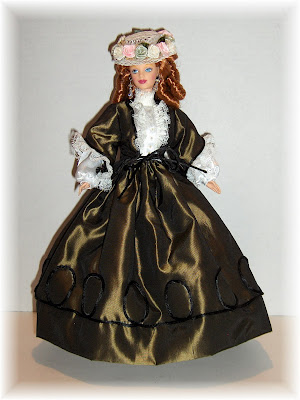Evening wear 1876
Created by Judy Frank
The most influential designer of the time was Englishman Charles Frederick Worth, dressmaker to the Empress Eugenie and the court of France's second empire. He was the founder of the haute couture industry with the creation of the "House of Worth." For fifty years it stood as the dominant fashion force in Europe and America, especially among ladies of royalty and the upper echelons of society. In his role as fashion innovator, he led late Victorian fashions into new shapes and ingenious means of construction, such as the princess line - a fitted seamless waistline - and variations on the bustle.
Evening wear early 1870's
Created by Willem van der Leer
By the 1860's, skirts were slimmed down below the waist by means of gores rather than gathers, and the princess cut was lending a funnel rather than a dome shape to skirts. Also during the 1860's the bonnet began its decline, and smaller - even brimess - hats came into vogue. By the late 60's, the shorter walking dress was favored for women's outdoor excursions
By the 1870's the crinoline was losing ground, and the interest in women's silhouettes was shifting to the back via the bustle. Initially, the shape was still full - with only the overskirt being pulled to the rear to form the bustle; but by the end of the decade the skirt was becoming more vertical, with an elaborate bustle generally ending in a train. Both the popular cuirass bodice - a very tight, boned out garment extending from chest to hip intended to mold the body - along with the princess sheath, imparted a slimming appearance to women.
Walking Suit 1882
Created by Judy Frank
Throughout the 1880's the bustle remained constant, although the skirt became less voluminous. Finally, by the 1890's, the bustle had virtually disappeared in favor of the princess line with gored skirts, a silhouette that would remain popular until the end of the century.
Boots and shoes were almost always worn with heels and pointed or squared toes. Accessories added to the elaborateness of the outfit. Capes, shawls, cloaks, mantles, scarves and little aprons were worn. Also, gloves and parasols were popular. Purses were sometimes attached to the waist belt. Large brooches were worn at the throat and large or small earrings were also worn. Tortoiseshell combs were fashionably worn in the hair. Boas were also worn and made of fur or feathers.
The "Gibson Girl" made her appearance in the 1890's
Costume designed by Mattel
The hair was periodically worn in a style to reflect the dress, which also made the hairstyle very complicated. It was worn thick, long and luxuriant and in many different arrangements. The front hair was worn frizzed or curled to form a fringe now and then. At times false hair was worn with real hair. Hats were also an important part of the outfit. They were decorated with feathers, flowers, ribbons, lace, embroidery and buckles. Hats were tied under the chin with ribbons or worn with hat pins to keep them in place. They were worn on the top or back of the head or tipped forward. Brims were generally small and sometimes curling or up turned in front. The hat itself was usually small, although around 1886 large, tall hats were fashionable.
By 1900, fashions had made a dramatic metamorphosis since 1837, the year Queen Victoria ascended the throne of England. A new century was born and fashions would never be the same again. The role of women - the way they thought amd the way they dressed - was changing, and future fashion styles would reflect this. This will become more obvious in the years leading to the First World War.
Morning Ensemble 1900
Created by Ana Delia Mercado
I hope you have enjoyed this second and final chapter to the Victorian Era, and perhaps have gained a better appreciation of the fashions of this period. All dolls shown are from my collection.





































